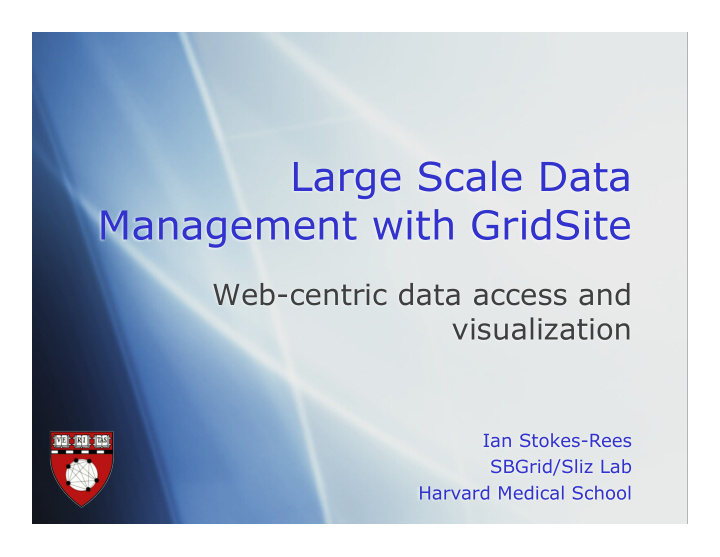



Large Scale Data Management with GridSite Web-centric data access and visualization Ian Stokes-Rees SBGrid/Sliz Lab Harvard Medical School
Workflow Overview Stage 1: Protein sequence alignment 100,000 x 300 protein pair comparisons 1.5 days wall clock compute time Stage 2: Protein model construction 50 x 120 alignment of models to proteins 10-20 days wall clock compute time Stage 3: Cluster solutions 50 x 120 rotation alignments
Challenges Lots of files and data > 1 million files, 10 GB data per workflow iteration Workflow staging 3-5 stages, each dependant upon completion of previous stage and analysis of results DB not practical but need to put meta data into DB Combining security and sharing Collating results into tables and graphs
Approach Use GridSite to serve files via http(s) mod_gridsite plugin to Apache httpd Serve “site” and “user” files http://abitibi.sbgrid.org/se/data/site/jobs http://abitibi.sbgrid.org/~ijstokes/jobs Job input and output (tarballs) carefully constructed file names and directories Each atomic job self-summarizes collated results via cat */summary.row > summary.dat
Key Features of GridSite GACL Simple security policies, based on X.509 DN or DN group <gacl> <entry> <person> <dn>/DC=org/DC=doegrids/OU=People/CN=Ian Stokes-Rees 411174</dn> </person> <allow><list/><read/><write/><admin/></allow> </entry> </gacl> Shared header and footer allows construction of simple HTML gsexec precursor to glexec allows user to use web i/f to run CGI commands as local user htcp Make use of HTTP PUT and DELETE SlashGrid FUSE module that allows file system mounting of mod_gridsite enabled directories, based on GACL permissions.
Content Delivery Static content Accessible via well defined URLs RESTful principle Conceptually easy to think of data organized identically to file system “Dynamic” content Generate summary tables and graphs Provide hyperlinks to details Image map hyperlinking is nice Slowly adding in AJAX features (jQuery) Link between portal (Django) and GridSite is a challenge
Sage Math Python-based scientific/mathematical programming and data exploration environment Packages many scientific extensions to Python Web-based “notebook” for data sharing and exploration For most people, can replace 100% of Matlab and benefit of very similar syntax We use this for data analysis and generation of graphics
Take away points GridSite provides some great features Can secure web content using simple file -based ACLs tied to existing X.509 PKI Combining web-centric data access with file-system features gives best of “both worlds” for large data sets Missing piece is DB-based search and dynamic content generation coming soon with Django portal Sage Math is an easy way to integrate powerful data analysis and graphics
Summary Acknowledgements: OSG Task Force: Abishek Rana, Greg Thain, Terrence Martin, Jeff Porter, Steve Timm Andrew McNab (GridSite author) Piotr Sliz (PI for SBGrid) Ruth Pordes (continued encouragement with OSG) Members of osg-* mailing lists Any questions? http://sbgrid.org ijstokes@crystal.harvard.edu Ian Stokes-Rees
Recommend
More recommend